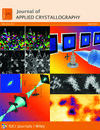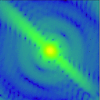issue contents
Ptychography: software and technical developments
Edited by Stefano Marchesini, David Shapiro and Filipe R. N. C. Maia
This virtual issue collects together a series of articles on software and technical developments in ptychography that were originally published in the journal throughout 2020.

Cover illustration: Some images from the special issue Ptychography: software and technical developments. Courtesy of Chang et al. [J. Appl. Cryst. (2020), 53, 1283–1292], De Caro et al. [J. Appl. Cryst. (2020), 53, 741–747], Pound et al. [J. Appl. Cryst. (2020), 53, 1276–1282] and Wakonig et al. [J. Appl. Cryst. (2020), 53, 574–586].
Free 

A virtual special issue of Journal of Applied Crystallography brings together 14 articles from developers and practitioners in the field of ptychography, highlighting some developments in software and algorithms, instrumentation, technical requirements, and applications.
Open  access
access
 access
accessSimultaneous wavefront metrology and sample projection imaging with multi-layer Laue lenses using the ptychographic X-ray speckle tracking technique is described. Results from three experiments are presented.
Open  access
access
 access
accessThe program speckle-tracking is described, an open-source software suite for performing wavefront metrology and sample imaging from projection in-line holograms of a sample.
Open  access
access
 access
accessA method for the simultaneous measurement of a wavefront's phase and the projection hologram of an unknown sample is presented. This method relies on an updated form of the speckle tracking approximation, which is based on a second-order expansion of the Fresnsel integral.
Open  access
access
 access
accessDifferent studies in X-ray microscopy have arrived at conflicting conclusions about the dose efficiency of near- and far-field imaging approaches. X-ray far-field ptychography is compared with near-field holography and near-field ptychography in computer simulations. All three methods are highly dose efficient, with far-field ptychography offering slightly better low-dose imaging characteristics.
This work describes the application of X-ray ptychography for the inspection of complex assemblies of CdSe/CdS octapod nanocrystals embedded in 24 ± 4 µm-thick polymethyl methacrylate and polystyrene matrices.
Open  access
access
 access
accessUnderstanding the wavefront of ultra-bright and ultra-short pulses of X-ray free-electron lasers is both important and challenging. A method based on ptychography that can retrieve full high-resolution complex-valued wave functions of individual pulses is presented.
Open  access
access
 access
accessDocumentation is presented for the first ptychographic X-ray computed tomography experiment on the NanoMAX beamline, along with a quantitative analysis of the reconstruction quality and a discussion of possibilities for future improvements.
Open  access
access
 access
accessThe ptychographic nano-analytical microscope (PtyNAMi) is designed for in situ/operando high-resolution imaging in two and three dimensions with high sensitivity and structural, elemental, chemical and electronic contrast.
X-ray ptychography is used to illustrate the high quality and high coherence of a `parasitic' beam in an X-ray free-electron laser. Use of such geometries would greatly increase the availability of beamtime at these large-scale high-demand facilities.
To characterize the transmission matrix and determine the crystal or orbital orientation in a material with high-resolution mapping of transmission properties, the linear-dichroism scattering model in ptychographic imaging is introduced. Via the proposed efficient two-stage reconstruction algorithm, the dichroic transmission matrix can be recovered without an analyzer by using ptychography measurements with as few as three different polarization angles.
Open  access
access
 access
accessSpectroscopic ptychography is a powerful technique to determine the chemical composition of a sample with high spatial resolution. This paper presents a novel algorithm to iteratively solve the spectroscopic blind ptychography problem.
A scientific computing approach is described for ptychographic reconstructions at Sirius, the new fourth-generation Brazilian synchrotron.
Open  access
access
 access
accessA new computer program for analysing ptychographic data combines both high-level simplicity and high-performance computing on large-scale computing clusters. It is available with a royalty-free non-exclusive licence for academic and non-commercial purposes.
PyNX is a toolkit with assorted Python modules and command-line scripts which can be used for the analysis and simulation of coherent X-ray imaging, including techniques such as coherent diffraction imaging, ptychography and wavefront propagation, in the near- or far-field regime. All calculations can be executed solely on graphical processing units (GPUs) for accelerated computing. Elementary algorithms can be easily tailored, built upon and combined using an operator-based approach, allowing full flexibility with high-performance computing. Calculations can be distributed on multiple GPUs using MPI, e.g. for large ptychography data sets.


 journal menu
journal menu

































